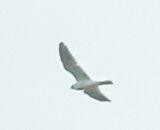White-tailed Kite
|
|
| White-tailed Kite | ||||||||||||||
|---|---|---|---|---|---|---|---|---|---|---|---|---|---|---|
 | ||||||||||||||
| Scientific classification | ||||||||||||||
| ||||||||||||||
| Binomial name | ||||||||||||||
| Elanus leucurus (Vieillot,, 1818) |
The White-tailed Kite (Elanus leucurus) is an elanid kite found in western North America and parts of South America. It was formerly known as the Black-shouldered Kite.
The earliest name for this bird was the White-tailed Kite, and it was given the systematic name Elanus leucurus. However, it was argued that it was a subspecies of a European and African species, Elanus caeruleus, at the time known as the Black-shouldered Kite (see, for example, Parkes, 1958), and the recognised name was changed.
More recently, Clark and Banks (1992) argued that the White-tailed Kite differed from the Old World species in size, shape, plumage and behaviour, and that these differences were sufficient to warrant specific status. This argument was accepted by the American Ornithologists' Union, so the White-tailed Kite has its original name back. Meanwhile E. caeruleus has been renamed as the Black-winged Kite, and the name Black-shouldered Kite is now reserved for an Australian species, Elanus axillaris, which had also been merged into E. caeruleus but is also now regarded as separate.
The White-tailed Kite was rendered almost extinct in the 1930s and 1940s by shooting and egg-collecting, but they are now again common in California. Their distribution is sporadic, however; they can be seen in the Central Valley and southern coastal areas, and also around the San Francisco Bay. They are also found in southern Texas, on the Baja California peninsula, and in eastern Mexico.
White-tailed Kites feed principally on rodents, and they are readily seen patrolling or hovering over lowland scrub or grassland. Their coloration is gull-like, but their shape and flight falcon-like, with a markedly forked tail. Mainly white underneath, they have black wingtips and shoulders. Outside the breeding season they roost communally in groups of up to 100.
References
- Clark, W. S., & Banks, R. C. (1992). The taxonomic status of the White-tailed Kite. Wilson Bulletin, 104, 571.
- Parkes, K. C. (1958). Specific relationships in the genus Elanus. Condor, 60, 139-140.
